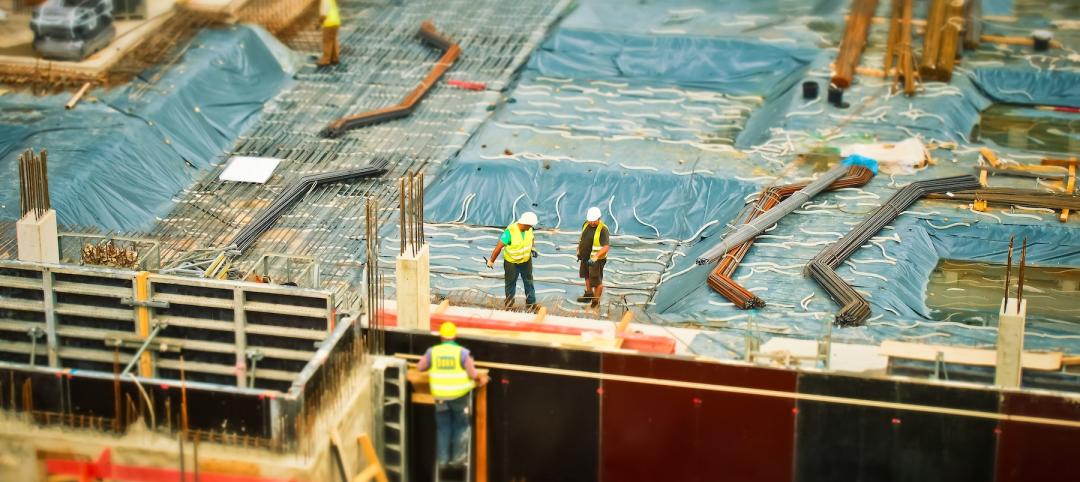Collaboration is fundamental to the mission of the Old Town School of Folk Music. Founded in 1957, the thriving Chicago nonprofit offers multicultural music, dance, theater, and visual arts courses and concerts, with users running the gamut from “Wiggleworm” tots to senior citizens. The school serves about 6,000 students a week, and performances attract 85,000 people annually. Pros often jam with rank beginners, reflecting a spirit of teamwork inspired by the institution’s folk roots.
Despite continuing success, OTS has always operated in reused buildings. Its current facilities include a 19th century banquet hall (renovated in the 1980s) and a 1930s library repurposed as the school’s headquarters in the late 1990s. When the school decided to squeeze its first purpose-built facility into a tight site across the street from its HQ, the Building Team’s collaborative skills proved a good match for the OTS vibe.
The new 28,000-sf East Building includes small spaces for music instruction and practice, a multipurpose hall for performances and parties, three skylit dance studios, and a public “front porch” entry hall. Because room-to-room sound leakage was a longstanding headache, excellent acoustics were a priority.
The open staircase, with stylized portraits of music legends, is the primary feature of the entrance lobby, or “front porch.” The multi-story “feature wall” creates acoustical separation between public areas and the music and dance classrooms, but interior windows maintain a sense of connection and distribute natural light. Soft seating invites informal jam sessions, and the terrazzo floor is studded with recycled beer bottles—a wry nod to the historic connection between music and libations.
The site, on a busy commercial avenue, posed significant issues that became more evident upon further investigation. The water table was high, and any excavation deeper than 11 feet would require tedious permitting through the city’s Office of Underground Construction. The proposed building height, though not unprecedented in the neighborhood, would violate recent zoning language created to prevent development of tall condo buildings.
These factors derailed initial plans to create a four-story facility with a basement. OTS and its architect, VOA Associates, deleted executive offices and storage from the program, resulting in a three-story, no-basement building plus a rooftop mechanical zone. (A return to earlier zoning language was negotiated to address the height restriction, and some of desired building functions were accommodated in a small storefront next to main OTS building.)
Bill Ketcham, AIA, LEED AP, Principal at VOA, says, “We didn’t lose anything that was mission-critical. Through a legitimate budgeting process we managed to maintain quality; I don’t think we were hurt very badly on the value enhancement.”
In addition to owner’s rep The AT Group, acoustical specialist Talaske was an early player. “We knew we needed a highly qualified acoustical consultant from day one, so we didn’t screw that up,” says Ketcham.
Seen from inside a music practice room, the feature wall consists of an inner layer that incorporates fire-rated glazing and fabric-covered acoustical panels, and an outer layer on the public circulation side, which includes glass-fiber-reinforced gypsum frames surrounding the windows. The walls are isolated from each other down to the foundation.
Bulley & Andrews was also hired early, in part because the construction manager had submitted a detailed analysis of how the project could be staged without snarling traffic. “This was quite compelling to us,” says Ketcham. “The building takes up the entire lot, and there’s no parking, so the plan was to frame out the front bay last to allow for staging within the building. Old Town does have a parking lot a couple doors down, and they worked out a plan to use that lot for staging, with the alley available for moving people and materials. Major deliveries were brought in the front during off hours. Lincoln Avenue is pretty congested, but most of the retailers there also do street loading. There was very good coordination with the alderman’s office and the local merchants.”
OTS Executive Director Bau Graves says, “We did community meetings prior to the start, and Bulley & Andrews’ superintendent on the site continually talked with everybody about everything going on. We also offered biweekly tours, and I know most of our neighbors went through at least once, and several more than once, during the construction.”
Notable features of the project include:
• Energy conservation. Operating costs were top-of-mind for OTS, in light of experiences with its headquarters project. The former library, considered sustainable at the time of its renovation with electric heat, had proved costly to operate once the local utility’s promotional rate lock expired. OTS selected natural gas and high-efficiency HVAC for the new LEED Gold building.
• Acoustical design. Robust steel framing and sophisticated isolation technology offer sound control. A full-height “feature wall,” punctuated with recessed slot windows, visually and acoustically separates the music and dance areas from the public lobby.
• Flexible space. Bleachers in Szold Hall, a 2,100-sf room on the second floor, can support 150 seats for concerts but fold back to open the column-free space for dance classes and receptions.
• Contextual design. The front façade echoes the Art Deco library with vertical windows and orange brick. Decorative precast concrete panels feature the word “music” in ancient and modern languages, recalling the library’s decorative terra cotta plaques. Side facades are primarily gray-painted steel: a plain, money-saving treatment that helps downplay the bulk of the building when viewed from the north or south.
Eighteen months after completion, Graves has nothing but praise for those who made the project a reality. “The Bulley & Andrews team, the VOA team, the owner’s rep, all the main players worked through a lot of issues that any job of this scale will represent, and did it with a great deal of tact and forbearance. People told me we’d never want to see our architect again after this kind of job, but we all ended up being good friends.”
Project summary
SILVER AWARD
Old Town School of Folk Music, East Building
Chicago
BUILDING TEAM
Submitting firm: VOA Associates (architect)
Owner: Old Town School of Folk Music
Owner’s rep: The AT Group
Structural: Matrix Engineering
MEP: Primera Engineers Ltd.
Civil: Gary A. Wiss
Acoustical: Talaske
CM: Bulley & Andrews LLC
GENERAL INFORMATION
Project size: 28,070 sf
Construction cost: $13 million
Construction time: Summer 2010 to fall 2012
Delivery method: CM at risk
Related Stories
| Aug 17, 2022
New York to deploy 30,000 window-sized electric heat pumps in city-owned apartments
New York officials recently announced the state and the city will invest $70 million to roll out 30,000 window-sized electric heat pumps in city-owned apartments.
| Aug 17, 2022
IBM’s former office buildings in Boca Raton turn into a modern tech campus
Built in 1968, the Boca Raton Innovation Campus (BRiC), at 1.7 million square feet, is the largest office campus in Florida.
| Aug 16, 2022
DOE funds 18 projects developing tech to enable buildings to store carbon
The Department of Energy announced $39 million in awards for 18 projects that are developing technologies to transform buildings into net carbon storage structures.
| Aug 16, 2022
Multifamily holds strong – for now
All leading indicators show that the multifamily sector is shrugging off rising interest rates, inflationary pressures and other economic challenges, and will continue to be a torrid market for design and construction firms for at least the rest of 2022.
| Aug 16, 2022
Cedars-Sinai Urgent Care Clinic’s high design for urgent care
The new Cedars-Sinai Los Feliz Urgent Care Clinic in Los Angeles plays against type, offering a stylized design to what are typically mundane, utilitarian buildings.
| Aug 15, 2022
IF you build it, will they come? The problem of staff respite in healthcare facilities
Architects and designers have long argued for the value of respite spaces in healthcare facilities.
| Aug 15, 2022
Boston high-rise will be largest Passive House office building in the world
Winthrop Center, a new 691-foot tall, mixed-use tower in Boston was recently honored with the Passive House Trailblazer award.
Architects | Aug 12, 2022
Goettsch Partners names James Zheng, CEO, and Paul de Santis, Co-design Director
Global architecture firm Goettsch Partners (GP) announces that James Zheng, AIA, LEED AP, has been named CEO, and Paul De Santis, Assoc. AIA, LEED AP, joins James Goettsch, FAIA, as co-design directors for the practice. As the primary partners in the firm, the three have worked closely together for more than 17 years. Goettsch will also continue to serve as chairman while Zheng now assumes the full CEO title as well as president.
| Aug 12, 2022
Monthly Construction Input Prices Decreased 2% in July, Up 17% From a Year Ago, Says ABC
Construction input prices decreased 1.8% in July compared to the previous month, according to an Associated Builders and Contractors analysis of U.S. Bureau of Labor Statistics’ Producer Price Index data released today.
Hotel Facilities | Aug 12, 2022
Denver builds the nation’s first carbon-positive hotel
Touted as the nation’s first carbon-positive hotel, Populus recently broke ground in downtown Denver.



















